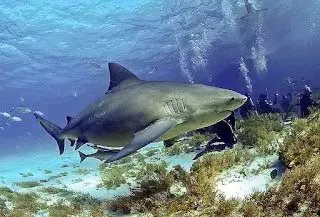When Crocodiles and Sharks Swam in Taal Lake
Although, in the present day, the waters of Taal Lake have become completely freshwater, this was not always the case. The lake used to be a bay or inlet that connected to Balayan Bay until it was cut off almost completely by debris cast into the atmosphere by the prolonged 1754 eruption of Taal Volcano. Today, the Pansipit River is the lake’s only link to the bay.
Before 1754, because the lake was still an inlet with waters flowing from Balayan Bay, these waters were “salty or brackish,” brackish being “slightly salty” in reference to where saltwater and freshwater combine such as in river estuaries1. In a 2010 paper, scientists Papa and Mamaril wrote:
“Spanish and American explorers, missionaries and scientists were the first to document the lake with maps, e.g., Murillo Velarde’s map, drawn from exploratory expeditions since Juan de Salcedo’s expedition in 1570. These accounts described the lake to have salty or brackish water where sharks, tunas, snakes and other organisms abound and where the active Taal Volcano Island is found2.”
“In 1754 (in reference to the prolonged eruption that year), “the lake waters threw up dead alligators and fish.” Umali refers to sharks in Taal Lake3.”
The two historians made a slight mistake in using the word “alligators” because these are a different species altogether and are endemic only to certain areas of the United States and China4. The “alligators” referred to must have been one of two species of crocodiles found in Philippine waters: the smaller Philippine or Mindoro crocodile, endemic to the country only and once had habitats as far as northern Luzon5; and the much larger saltwater crocodile found from in “India's east coast across Southeast Asia and the Sundaic region to northern Australia and Micronesia6.”
Both are no longer found in Taal Lake. Batangas History, however, is unable to find any references that state when they disappeared from the lake, albeit hunting and habitat loss were likely the reasons.
Meanwhile, the species of shark that used to swim in Taal Lake, according to Yves Bouquet, was the bull shark7. Most people will probably associate sharks with marine or saltwater, which is understandable since most are, indeed, found in this type of environment.
The bull shark, an aggressive species, is able to survive “in warm, shallow brackish and freshwater systems including estuaries” and “thrive in both salt and fresh water and can travel far up rivers8.”
This ability to survive in both environments allowed bull sharks to keep making the journey through the Pansipit River9 to Taal Lake from Balayan Bay even after the 1754 volcanic eruption sealed the bay or inlet, something which, in time, transformed the waters completely fresh as it is in the present day.
In fact, they were still present in the Taal Lake, surviving the vicious 1911 eruption of the volcano, well into the American colonial era but ultimately became victim to the most dangerous predator of all. According to Hargrove and Medina, the late Filipino ornithologist and conservationist Dioscoro Rabor10 hand confirmed that:
“...sharks once swam Lake Taal waters, but says that they were exterminated by overfishing in the 1930s11.”
2 “History of the Biodiversity and Limno-ecological Studies on Lake Taal with Notes on the Current State of Philippine Limnology,” by Rey Donne S. Papa and Augustus C. Mamaril Sr., published 2010, online at Philippine Science Letters.
3 “Sunken Ruins in Taal Lake: An Investigation of a Legend,” by Thomas R. Hargrove and Isagani Medina, published 1988 in the Ateneo de Manila University journal Philippine Studies.
4 “Alligator,” Wikipedia.
5 “Philippine crocodile,” Wikipedia.
6 “Saltwater crocodile,” Wikipedia.
7 “The Philippine Archipelago,” by Yves Bouquet, published 2017 in Switzerland.
8 “Bull shark,” Wikipedia.
9 “Pansipit River,” Wikipedia.
10 “Dioscoro S. Rabor,” Wikipedia.
11 Hargrove and Medina, ibid.

